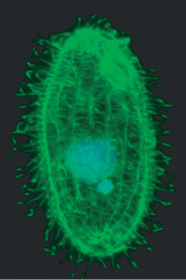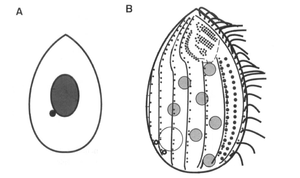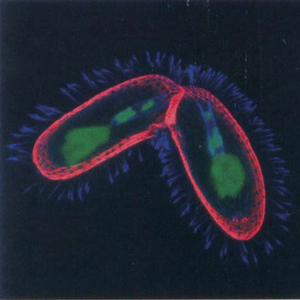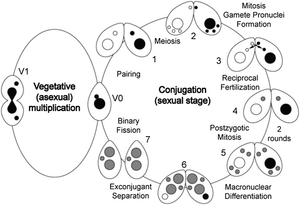Tetrahymena thermophila: Difference between revisions
| Line 48: | Line 48: | ||
[http://journals.plos.org/plosbiology/article?id=10.1371/journal.pbio.0040286#pbio-0040286-g007 Eisen, J., et al. “Macronuclear Genome Sequence of the Ciliate ''Tetrahymena thermophila'', a Model Eukaryote”. ''Public Library of Science''. 2006. Volume 4. p. 1620-1642.] | [http://journals.plos.org/plosbiology/article?id=10.1371/journal.pbio.0040286#pbio-0040286-g007 Eisen, J., et al. “Macronuclear Genome Sequence of the Ciliate ''Tetrahymena thermophila'', a Model Eukaryote”. ''Public Library of Science''. 2006. Volume 4. p. 1620-1642.] | ||
[http://www.pnas.org/content/103/1/165.full Klobutcher, L., et al. "The ''Bacillus subtilis'' spore coat provides 'eat resistance' during phagocytic predation by the protozoan ''Tetrahymena thermophila''." ''Proceedings of the National Academy of Sciences''. 2005. Volume 103. p. 165-170] | |||
[http://www.sciencedirect.com/science/article/pii/S0960982205004392 Collins, K., and Gorovsky, M. "''Tetrahymena thermophila''". ''Current Biology.'' 2005. Volume 15. p. R317-R318.] | [http://www.sciencedirect.com/science/article/pii/S0960982205004392 Collins, K., and Gorovsky, M. "''Tetrahymena thermophila''". ''Current Biology.'' 2005. Volume 15. p. R317-R318.] | ||
Revision as of 04:49, 30 April 2015
Classification
Higher order taxa
Eukaryota; Chromalveolata; Ciliophora; Oligohymenophorea; Hymenostomatida; Tetrahymenidae
Species
Tetrahymena thermophila
Description and Significance
Tetrahymena thermophila is a large, motile, phagocytic, unicellular eukaryote. The organism is about 20x50µm. T. thermophila live in temperate freshwater environments.
Tetrahymena is an essential model organism that has been used in many biochemistry oriented experiments to identify biological phenomena. Currently this organism is being used to study four major issues: cilia biogenesis, telomerase structure and function, small RNA mediated self versus non-self discrimination, and epigenetic inheritance.
Describe the appearance, habitat, etc. of the organism, and why you think it is important.
Genome Structure
T. thermophila contain two nuclei, a macronucleus and a micronucleus. Each has been sequenced[1]. The macronucleus is ultimately derived from the micronucleus. The micronucleus is diploid and contains 5 pairs of chromosomes. The macronucleus contains 45 copies of 275 chromosomes formed by fragmentation, as well as 9000 copies of the rRNA gene. The macronucleus contains 15% less genetic information than the micronucleus, which represents noncoding DNA and transposable elements. The macronucleus is kept intact through asexual reproduction by telomerase activity. Additionally the mitochondrial genome has been sequenced [2].
Cell Structure
Tetrahymena thermophila has all the basic structures of animal cells (ER, golgi, mitochondria, actin, tubulin etc.) except intermediate filaments. Additionally T. thermophila contain enlarged food vacuoles and a contractile vacuole which aids in regulating osmotic pressure. The cell has 18-21 rows of cilia lining its cell membrane. The cilia contain phosphonolipds which are resistant to degradation by phospholipase. Food enters the organism through the oral apparatus and exits through the cytoproct.
Metabolism
T. thermophila obtains energy through aerobic respiration. In lab T. thermophila's generation time is between 2-3 hours. It requires 11 essential amino acids, six B-complex vitamins, Fe3+ and trace metals. Additionally it is unable to synthesize purines and pyrimidines.
How it gains energy; what important molecules it produces.
Life Cycle
The presence of the two nuclei reflects T. thermophila’s ability to reproduce both sexually and asexually. During vegetative growth the macronucleus is transcribed, translated and transmitted to the next asexual generation by mitosis. Food stress induces T. thermophila to reproduce sexually, producing pronuclei by meiosis of the micronucleus and exchange with a cell of a different mating type. The macronucleus is ultimately derived from the micronucleus.
Ecology and Pathogenesis
Tetrahymena thermophila has been isolated in many states, but are found in fresh water ponds all over Eastern North America. T. thermophila tends to have localized distribution within the geographic areas where it is found. The organism is more abundant in the months of June through September. It is also more likely found in areas that contain decaying vegetation. They have been consistently isolated from ponds, particularly those that do not completely ice over during the winter months.
Habitat; symbiosis; biogeochemical significance; contributions to environment.
If relevant, how does this organism cause disease? Human, animal, plant hosts? Virulence factors, as well as patient symptoms.
References
Author
Page authored by Hannah Pak and Luke Pryke, students of Prof. Jay Lennon at Indiana University.




